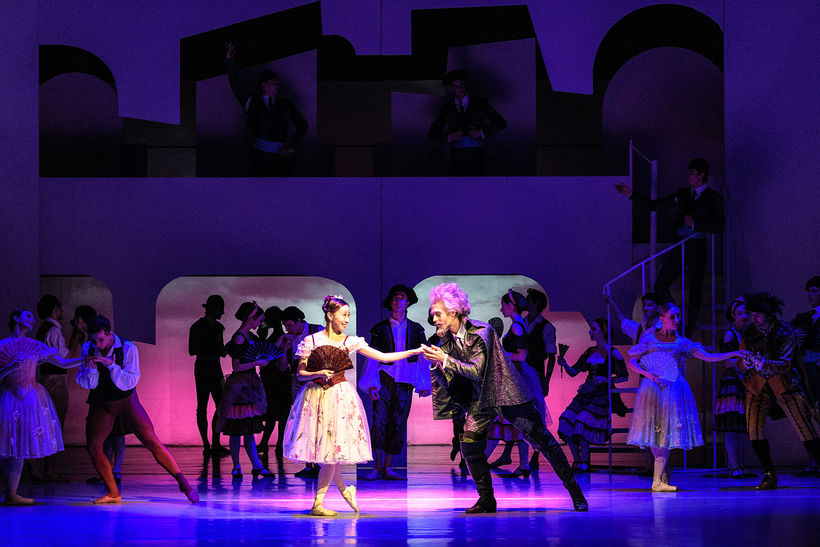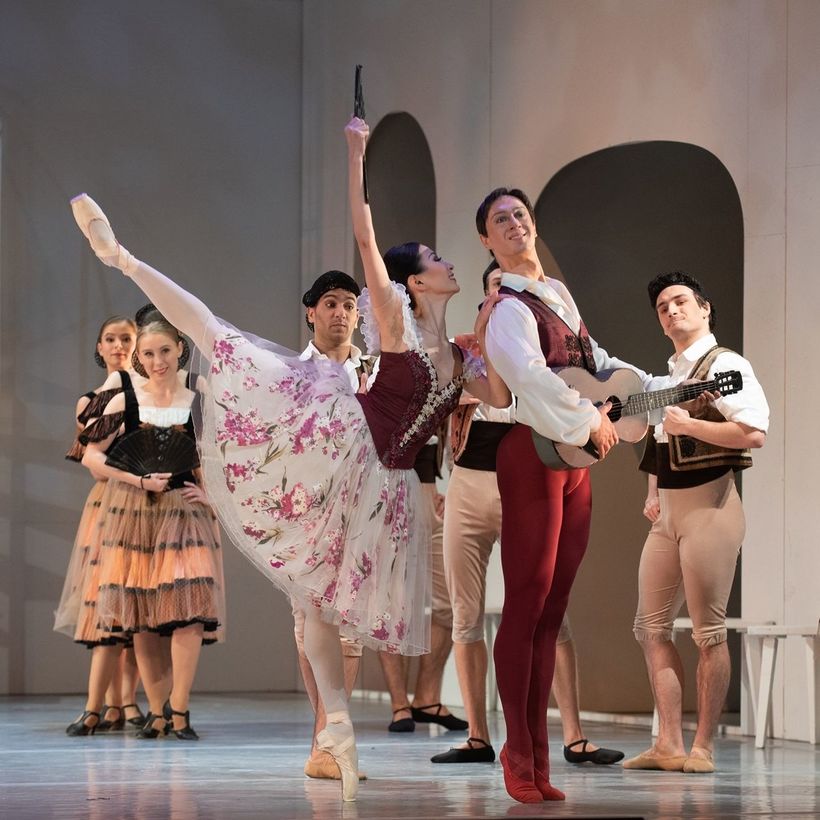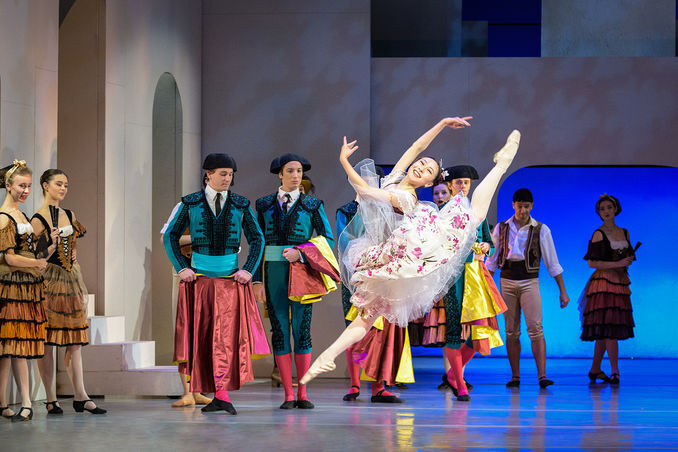Don Quixote returns to Plzeň after a two-decade hiatus – in the late 1990’s it was revived by Pavel Ďumbala and his assistant Miroslava Pešíková. The current version has been created by Plzeň ballet’s artistic director Jiří Pokorný, with character dances choreographed by Nelly Danko. Pokorný draws upon Marius Petipa and Alexander Gorsky’s choreographic canon, while Danko uses Boris Bregvadze’s 1986 version (for the National Theatre ballet) in which she excelled as the vivacious Mercedes.
Daniel Dvořák’s scenography features a minimalist, but solid-looking decoration, devoid of any references to a place or time the story is set in. The stage is framed by hinted facades, an arcade in the backdrop and a spiral staircase resembling a fire escape. The stage design comprises projections on a few occasions: hardly visible flames during the gypsy dance scene, and nebula projected onto the horizon to evoke the atmosphere of a starry night. Some traits suggest the influence of the Maori culture (a lamp, a large segmented window), while other remain rather implicit, such as a huge bust in the tavern scene. I must admit I probably missed Dvořák’s scenographic vision as the basic sets would work for any other production.
Dana Haklová’s overembellished costumes aim to recreate the atmosphere of the old-world Spain. As if the abundance of decorations was intended to make a contrast to Dvořák’s basic sets. The toreadors’ attires are heavily embroidered and come complete with typical toreador hats; some of the girls’ dresses are decorated with floral prints, the wealthy Gamache sports golden shoes and two layers of golden gloves. Sadly though, the colourful and exuberant costume design lacks a unifying style. An abrupt change comes in the dream scene. Dryads in large tutus interwoven with LED lights travel across a dimmed stage and more than anything else they resemble human-sized heavy fireflies. Instead of illusion and otherworldliness this scene is meant to convey, we watch a gloomy unpoetic dream.

The plot of the ballet is not complicated, yet it needs a steady-hand direction so that all comic situations and gags are on point and the characters are led smoothly through the fast-paced spectacle. Unfortunately, Jiří Pokorný failed to do any of that. Because of bad timing, some of the gags in the Act 1 did not come across, most comedic elements appeared clumsy, and some essential moments passed almost unnoticed – for instance Kitri and Basilio’s escape at the end of Act 1, and the exit of the main hero in the final scene of the ballet. The large potential of the comic role of Gamache, the foppish rival suitor for Kitri, remained untapped.
The main precondition for staging Don Quixote is that a company has excellent dancers possessing brilliant technique as well as comedic talent. The second cast in Plzeň did not seem to have either. The central couple – Richard Ševčík and Shiori Nirasawa – had good chemistry on stage and Ševčík in particular handled all acting situations perfectly. But both dancers were struggling with their own technical and physical limits, needlessly highlighted by the overly-demanding choreography. Nirasawa looks lovely, boasts great flexibility and light jump, but her pointework was neither effortless nor confident. Apparently, her stamina was not enough for such a large and challenging part. In the final variations, she was running out of energy and struggling to recover from mishaps in her fouettés. Ševčík’s turns were clean and fast, yet he pushed himself a bit too hard to show off show-stopping lifts and other technical tricks we know from famous impersonators of Basilio.

Ševčík’s dancing was dynamic and flashy, but it lacked pure classical form, though he managed to conceal his technical insecurities quite well. In short: he strived to make an impression of grand style but did not succeed. The partnering in the final adagio was also grinding. On the other hand, Karel Audy as Espada displayed technical maturity, although I would have appreciated more of that bullfighter cockiness. Afroditi Vasilakopoulou (Mercedes) was struggling in her Act 1 variation, but once she took off her pointe shoes, her dancing became much more assured and her vivacious dance in the tavern scene came out quite nicely.
The dream scene felt weighted not only because of the sets, by also because of the dancers’ unconvincing performances. Amor (Victorie Svetlana Roemer) was far from being sprightly and swift and Gaia Ponzhio’s Dryad lacked the lightness of high jump and solid technique.
We could see better dancing, though, such as the flower sellers Kristýna Miškolciová and Kristina Kodedová, and Mischa Alexander Halla as Sancho Panza. However, the stage presence of the whole company raised many questions. I appreciate permanent engagement of all the cast, but missed unison in group dances, as well as speed and preciseness. As if the production needed more rehearsal and detailed work. I got the same impression last year watching Anastasia. We can even compare – it is not so long ago that Don Quixote was staged in Olomouc (Hana Vláčilová) and Ostrava (Michal Štípa). And while both Moravian companies are objectively growing and progressing, the Pilsen ensemble seems to be experiencing a period of stagnation.
Written from the second premiere held on 20 November 2021, at the J. K. Tyl Theatre in Pilsen.
Don Quixote
Music: Ludwig Minkus, John Lanchbery
Choreography: Jiří Pokorný after Marius Petipa and Alexander Gorsky, Nelly Danko after Borise Bregvadze
Music staging: Norbert Baxa
Sets: Daniel Dvořák
Costumes: Dana Haklová
Premiere: 13 Nov 2021
Translation: Tereza Cigánková




Josef Bartos
Thank you for your thoughts. One got stuck in my mind – that passion makes us different from AI. Just yesterday I read…I am a dance critic. I am a member of an endangered species